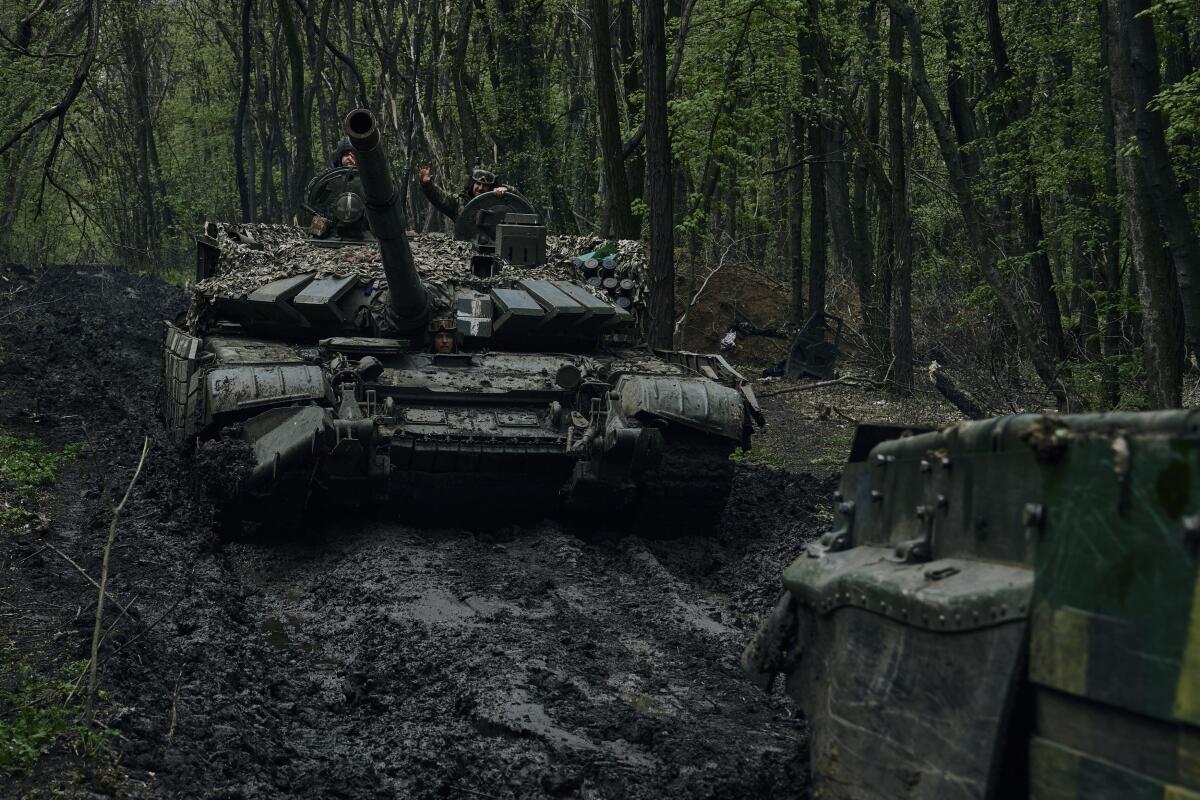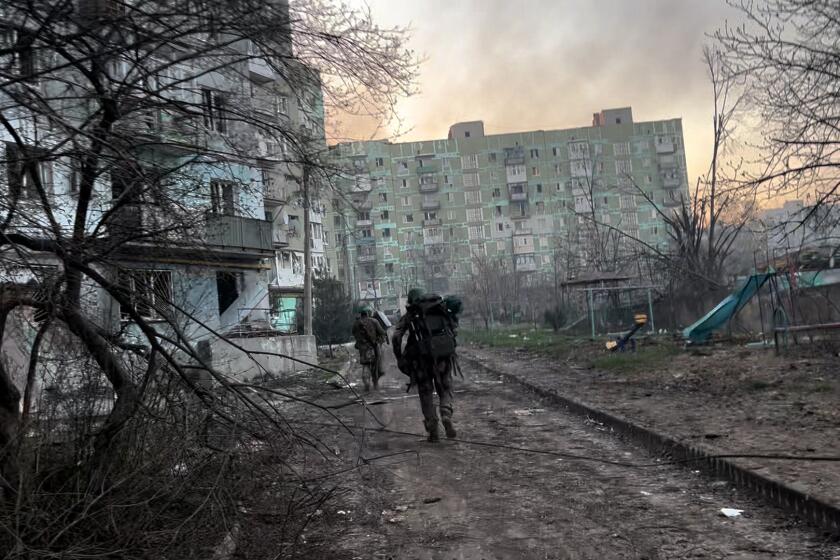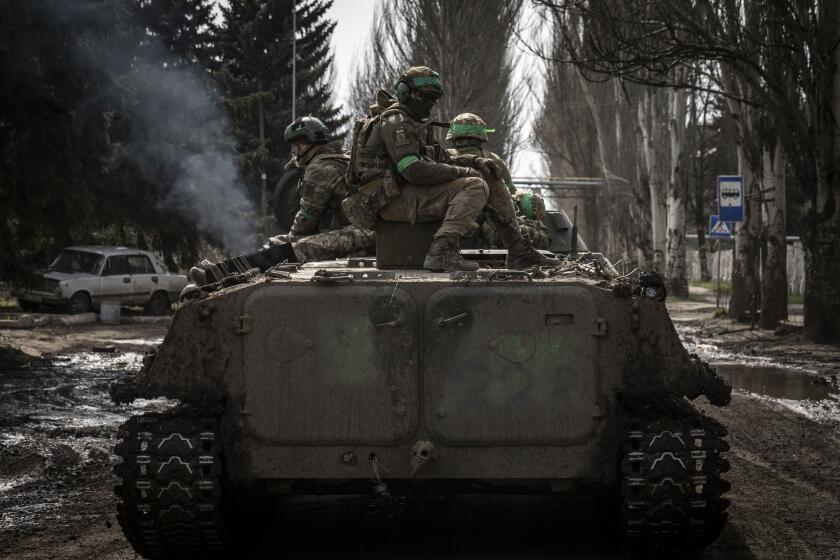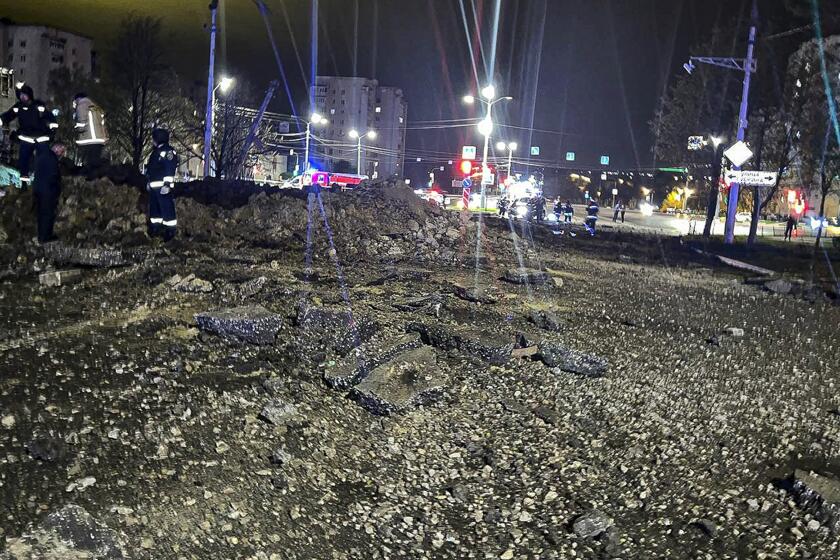Drones attack Sevastopol in Russian-occupied Crimea as a crashed drone is found near Moscow

- Share via
KYIV, Ukraine — Russian-appointed authorities in Crimea said the military fended off a Ukrainian strike on a main naval base Monday, while an exploding drone was also reportedly found in a forest near Moscow — attacks that come as Ukraine is believed to be preparing for a major counteroffensive.
The Moscow-appointed head of the port city of Sevastopol in Crimea, Mikhail Razvozhayev, said the military destroyed a Ukrainian sea drone that attempted to attack the harbor in the early hours and another one blew up. He said the powerful explosions shattered windows in several apartment buildings but didn’t inflict any other damage.
The attack was the latest in a series of attempted strikes on Sevastopol, the main naval base in Crimea, which Russia illegally annexed in 2014.
Ukrainian authorities didn’t immediately comment on Monday’s strikes. After previous attacks on Sevastopol and other areas, Ukrainian officials stopped short of openly claiming responsibility but emphasized the country’s right to strike any target in response to Russia’s aggression.
Russian news reports also claimed Monday that a Ukrainian exploding drone was found in a forest about 19 miles east of the Russian capital.
While it didn’t explode, the incident again underscored Ukraine’s ability to reach deep inside Russia as the Ukrainian military is thought to be preparing for a spring counteroffensive to reclaim occupied areas.
A top Ukrainian official has outlined a series of steps the government in Kyiv would take after the country reclaims control of Crimea from Russia.
Observers believe that the counteroffensive’s most likely target would be the Russian-held parts of the southern Kherson and Zaporizhzhia regions. If the push is successful, it would allow Ukraine to cut the land corridor between Russia and Crimea.
In what could be preparations for such a move, Ukrainian forces have recently established a foothold near the town of Oleshky on the eastern bank of the Dnipro River, according to the Institute for the Study of War, a Washington-based think tank.
Ukraine has recently received sophisticated weapons from its Western allies and new troops freshly trained in the West, giving rise to growing anticipation of an offensive.
U.S.-made Patriot missiles arrived in Ukraine last week, and military spokesman Yuriy Ihnat said Sunday on Ukrainian television that some have already gone into service.
As Ukrainian and Russian troops fight conventional battles, Europe’s first major war of the internet age has also sparked a war of technology.
Speaking after talks Monday with visiting Estonian Prime Minister Kaja Kallas in the northwestern city of Zhytomyr, Ukrainian President Volodymyr Zelensky commended the Baltic nation for its decision to hand over all of its 122-millimeter and 155-millimeter howitzers to Ukraine. “If each of the leaders and each of the states were as conscientious about the protection of our common freedom on the Continent, Russia’s aggression would have already known obvious defeats,” Zelensky said.
Russian forces, meanwhile, meanwhile, have continued their nearly nine-month effort to capture the Ukrainian stronghold of Bakhmut in the eastern Donetsk region.
Zelensky emphasized the importance of defending Bakhmut in an interview last month with the Associated Press. saying that its fall could allow Russia to rally international support for a deal that might require Kyiv to make unacceptable compromises.
Ukraine and Russia both have described the fighting for Bakhmut, the war’s longest battle, as key to exhausting enemy forces and preventing them from pressing attacks elsewhere along the 620-mile front line.
On Monday, Yevgeny Prigozhin, the millionaire owner of the Wagner military contractor spearheading the Russian offensive in Bakhmut, claimed that Ukrainian forces have been pushed into a small area of less than a square mile in the western part of the city. His claim couldn’t be independently verified.
If war is hell, there’s a credible case Bakhmut is its ninth circle, as Russia besieges the Ukrainian city that has symbolic, if not strategic, value for both sides.
“Our task is to grind the Ukrainian army down and prevent it from mounting a counteroffensive,” Prigozhin said.
He predicted that Ukraine will likely launch a counteroffensive during the next couple of weeks once the ground dries enough to allow tanks and other heavy vehicles to freely move off roads.
Ukraine’s military intelligence chief, Maj. Gen. Kyrylo Budanov, in an interview with RBC-Ukraine, described the planned counteroffensive as a “landmark battle in Ukraine’s modern history” that will see the country “reclaim significant areas.” “Everybody understands that we are getting close to it,” he said.
Russian military bloggers speculated that a Ukrainian counteroffensive could be accompanied by a slew of drone attacks on broad areas.
As anticipation builds for a counteroffensive, Ukrainian forces are desperate to lay their hands on Western tanks that could help turn the war’s tide.
Russian media identified the drone that fell near Moscow as a Ukrainian-made UJ-22 Airborne. They said it was found Sunday by a local resident. The reports alleged that the drone crashed after running out of fuel or hitting a tree. They said it carried 37 pounds of explosives.
The UJ-22 is a small reconnaissance drone that can carry about 44 pounds of explosives and has a range of autonomous flight of up to about 500 miles.
Last month, another drone that the authorities suspected also came from Ukraine was found in Shchelkovo, about nine miles northeast of Moscow, though it didn’t carry explosives.
Also in March, a heavy Ukrainian Tu-141 Strizh jet-powered drone exploded in the city of Kireyevsk in the Tula region about 125 miles east of Moscow, injuring three people, leaving a big crater and damaging several buildings. The Russian Defense Ministry said the drone was brought down by air defenses.
A powerful bomb accidentally dropped by a Russian warplane has hit the Russian city of Belgorod near the border with Ukraine, injuring two people.
Russian authorities have said that Ukraine has used the Soviet-made Tu-141 drones, with a range of about 620 miles, to strike facilities in Russia. In December, such drones hit two Russian air bases for long-range, nuclear-capable bombers. The Russian Defense Ministry said the drones were shot down, but it acknowledged that the debris damaged some aircraft and killed several servicemen.
In February, the authorities also reported that a Ukrainian drone was found in a forest near Gubastovo in the Kolomna region, about 50 miles southeast of Moscow. The drone fell close to a major natural gas pumping facility, its apparent target.
Another drone exploded in February in a forest near Kaluga, about 95 miles southeast of Moscow, hurting no one.
Ukraine’s presidential office said Monday that at least four civilians were killed and 13 others wounded by the latest Russian attacks over the previous 24 hours. Two people were killed in Bakhmut and two others in the southern city of Kherson.
More to Read
Sign up for Essential California
The most important California stories and recommendations in your inbox every morning.
You may occasionally receive promotional content from the Los Angeles Times.















